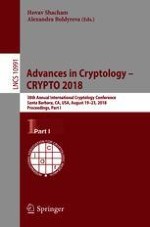2018 | OriginalPaper | Chapter
Non-Uniform Bounds in the Random-Permutation, Ideal-Cipher, and Generic-Group Models
Authors : Sandro Coretti, Yevgeniy Dodis, Siyao Guo
Published in: Advances in Cryptology – CRYPTO 2018
Publisher: Springer International Publishing
Activate our intelligent search to find suitable subject content or patents.
Select sections of text to find matching patents with Artificial Intelligence. powered by
Select sections of text to find additional relevant content using AI-assisted search. powered by
Abstract
-
defines the auxiliary-input (AI) RPM/ICM/GGM, which capture both non-uniform and preprocessing attacks by allowing an attacker to leak an arbitrary (bounded-output) function of the oracle’s function table;
-
derives the first non-uniform bounds for a number of important practical applications in the AI-RPM/ICM, including constructions based on the Merkle-Damgård and sponge paradigms, which underly the SHA hashing standards, and for AI-RPM/ICM applications with computational security; and
-
using simpler proofs, recovers the AI-GGM security bounds obtained by Corrigan-Gibbs and Kogan against preprocessing attackers, for a number of assumptions related to cyclic groups, such as discrete logarithms and Diffie-Hellman problems, and provides new bounds for two assumptions.
